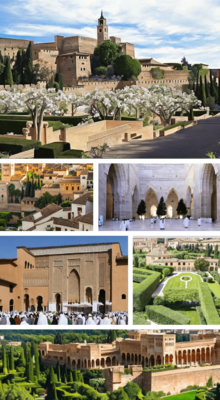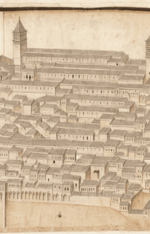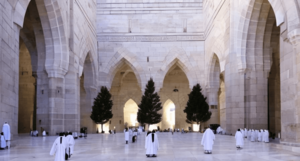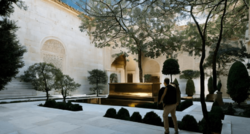Hazirat
| The Walled City of Hazirat | |
|---|---|
| Name as inscribed on the ARCHO Heritage List | |
 Clockwise from top:
| |
| Location | Tanjudan, Hindia Belanda |
| Type | Cultural |
| ARCHO subregion | Southwest Sythith |
| Inscription history | |
| Inscription | 2018 |
The Hazirat (Riysan: حازيرات) is a fortified city containing the Shrine of Al-Sayyid al-Mu'alim, the holiest site in Esoteric Shi'ism, and other structures and sites venerated by Esoteric Shias. Enclaved within the Hindia Belandan city of Tanjudan in Srambi Province and divided into 7 quarters, the Hazirat was the seat of the Auxiliary Imamate from the 11th century until the late 16th century, when the 10th Auxiliary Imam Siyyid Jacob moved the seat to Mount Ilias. From the 14th century until 1929, the Hazirat also formed part of the formerly sovereign Auxiliary Imamate, which controlled a number of incontiguous territories and possessions throughout modern-day Hindia Belanda. The walled complex remains under the management and ownership of the Shia Convocation and is today the focal point of the Rihlat, the Esoteric Shia pilgrimage held from 1-8 Rahmat (15-22 November) every year, as well as a major tourist destination.
There exists evidence of human settlements in the area where the Hazirat stands, dating from the 3rd century CE. Around the start of the 8th century, the area was known by the name of Atranjudan. It fell under the control of the Duchy of Srambi sometime in the 9th century and became a trading outpost along a trade route that spanned from Jartasti, modern-day Maqtajer, to the coastal parts of modern-day peninsular Hindia Belanda. By the time of Al-Sayyid al-Mu'alim's migration to the area in the 11th century, the area was known as Tanjudan and had a vibrant economy supported by mercantile presence and artisans. The northern part of Tanjudan, which the first Auxiliary Imam designated as the Hazirat, was given to Al-Sayyid al-Mu'alim and his followers by the Duke of Srambi, and over the course of several centuries became a centre of Esoteric Shi'ism after the burials of the religion's founder and other central figures within its boundaries.
The Hazirat encompasses an area of 12.17 km2 which partly occupies Bukit Tanjudan hill. The complex features expansive gardens, religious and administrative building complexes, shrines, Bayt al-Adhkars, pilgrims' houses and other sacred sites. Its Residential Quarter, Pilgrims' Quarter and Maqtajeri Colony are home to densely-packed and well-preserved residential buildings and compounds built in the 15th century, which today are occupied by approximately 5,400 out of 8,300 people who live within the Hazirat. It is served by its own fire brigade, post office and a Commonwealth Territorial Constabulary. Two hospitals, Ziekenhuis Hazirat and Zahrah Hospital, along with the Hindia Belandan-run Queen Margriet Hazirat School are situated within its walls. Administratively, the Hazirat falls within the territory of Gemeente Tanjudan and, thus, under the jurisdiction of the Mayor of Tanjudan. However, because the Shia Convocation privately owns the complex, an arrangement was reached by which municipal services that serve the property are partially-funded by the Shia Convocation.
The walled city is open to general visitors throughout the year, both for personal and guided tours. Its annual visitors, excluding pilgrims during the Rihlat, average about 6 million. In 2019 alone, the walled city was visited by 6.4 million visitors. The entrance fee for general visitors to the walled city, which helps fund maintenance of the complex, is HBR 2.00 for individual, non-guided visits, with options for guided visits and access to areas generally restricted to general visitors for an additional fee. During the Rihlat, the Hazirat is closed to non-Esoteric Shia visitors to accommodate the large influx of pilgrims inside the walled complex and maintain the orderly procession of pilgrimage. During the annual 8-day Rihlat pilgrimage, the Hazirat plays host to an average of 300,000 pilgrims, an occasion that presents great logistical challenges to the Hazirat.
History
Early history
The area that constitutes modern-day Hazirat saw human activity from as early as 1,000 BP. Bukit Tanjudan Hill, which is occupied partly by the Hazirat, may have been settled permanently by the 3rd century BCE.
Duchy of Srambi
In the 9th century, the Duchy of Srambi controlled the land that constitutes the Hazirat as part of the town of Tanjudan. The area was at this time headed by a Penghulu, a type of viceregal official common to many pre-colonial states in the Hindia Belandan archipelago. Much of the land in the area was controlled by a number of clans, the most prominent of which were the Tamardans, by whom the area that would later become the Hazirat was owned. The Tamardans, as with many clans of Tanjudan, were a mercantile group who commanded the largest of the trade caravans of the town.
Under the Duchy of Srambi, the town of Tanjudan grew exponentially and would later encompass the nearby hills of Bukit Tanjudan and surrounding valleys, becoming a trading city and a major stopover along a trade route that spanned from coastal peninsular Hindia Belanda to modern-day Maqtajer.
Little information is known about the the city of Tanjudan during this period, other than its trading activities, the clans who inhabited it as well as prominent placenames. It was only shortly before the arrival of the Esoteric Shias from Jartasti that more documentation of the city was made, mostly by Esoteric Shia refugees who settled there.
There is evidence of Yazidi presence in the area dating from the 9th century. A stela emblazoned with a peacock, symbolising Melek Tawus, was discovered within the Hazirat in 1938, during an excavation project. A number of stone tablets with Yazidi prayers inscribed on them were also uncovered at that time, suggesting that there was vibrant movement between Jartasti and the Duchy of Srambi.
Early Esoteric Shi'ism
Early Esoteric Shias sought refuge in Tanjudan from Zahiri Shia persecutions. The first wave of migration was led by a group of early believers numbering fewer than fifty, who were allowed to settle under the protection of the Duke of Srambi. More Esoteric Shia refugees would arrive later, accompanied by Al-Sayyid al-Mu'alim himself, following the revelation of verses 1-8 of Kalimatu'l-Aman in the Lisan al-Hikma:
He is the Merciful, the Lord of all things. Go, O thou beloved of the All-Merciful, to the land of Tanjudan, and leave thou the land of the Peacock Worshippers. Go thou there and take with thee the believers who have attained unto this new Revelation, for God hath ordained that thou settlest there. But if some of them [the believers] elect to stay amidst the oppressors, do not thou then prevent them [from staying]. And say unto the believers who elect to stay: “take ye refuge under the security of the Peacock Worshippers, for they are a people most tolerant upon whom are showered the blessings of the All-Merciful." And elect from amongst the believers who stay as thine emissary, that they [the believers] may not be severed from the blessed outpourings of Our Revelation. Journey, O Deputy of the Hidden Imam, to that land in the name of thy Lord, thy God Who hath called the realm of creation into being and hath created thee out of nothingness.
In the final years of Al-Sayyid al-Mu'alim's ministry, the pilgrimage was ordained by verses 7-9 of Kalimatu'r-Rihlat in the Lisan al-Hikma:
"O thou beloved of the Lord: proclaim the sacred journey [al-rihlat] to the believers in the north and south, east and west, that they may proceed into the Sacred Precincts whose dust We have, in truth, sanctify and upon which the steps of those such as have perceived Me with the vision of the sincere shall tread. They shall come to thee in multitudes and assemble at the appointed place, and be reckoned with those who have apprehended the true meaning of our changeless ordinance, clothed anew with robes of gladness and immersed in the living waters of Our Cause. Thus have We commanded thee and guided thee unto Our Sacred Thresholds, amidst the community of Our beloved, that thou mayest cognise the manifest truth from the errors of men and their enmity, and achieve thereby the unity of mankind. Go forth, then, by Our permission, to the land of the felicitous, the Sacred Sanctuary and the Safe Refuge for they who are oppressed for professing that there is none worthy of worship save Me, and there partakest thou of the Choicest Wine which We have proffered to mankind from pre-eternity. Potent are We to enjoin whatsoever We please."
The Duke of Srambi converted to Esoteric Shi'ism in 1070. Following his conversion, he provided Al-Sayyid al-Mu'alim with a patch of land where he and the early Esoteric Shias could form a permanent settlement. This area would later expand with the construction of residential areas, religious buildings and public spaces. The area's religious significance to Esoteric Shias was cemented with the burial of Al-Sayyid al-Mu'alim within the complex in 1093. The presence of his resting place and the growing number of Esoteric Shias living around the area made the place a de facto bastion of Esoteric Shi'ism in the following centuries.
When the first Auxiliary Imam Siyyid Karim I acceded to the Auxiliary Imamate, he designated the area as the "Hazirat" within which certain rules are to be observed by Esoteric Shias, given the sanctity of the site owing to being the resting place of the religion's founder. He also instituted the annual Rihlat pilgrimage and codified the rituals and observations associated with the 8-day pilgrimage to the site and surrounding places of religious significance. Outside the Hazirat proper, there are boundary points that form an area called the "Sacred Precincts", which were defined by the same Auxiliary Imam. This area includes the modern-day city of Tanjudan and extends west to the Barren Plains, where the Tanjudan International Airport is located today.
The area of the Sacred Precincts plays an important role in the annual Rihlat pilgrimage. Esoteric Shias who intend to perform the pilgrimage must enter into a state of consecration, or Iqtidas, prior to crossing into the Sacred Precincts. As the majority of pilgrims arrive by plane in modern times, they normally enter into the state of Iqtidas mid-flight before their planes cross the boundary. Pilgrims arriving by land traditionally cross the boundary through certain crossing points, called "atraf", which delimit the Sacred Precincts.
Over time, and under the successive reigns of Auxiliary Imams, the Hazirat became a walled city. The first construction of defensive walls at the Hazirat enclosed only what is today the Sacred Quarter. Further constructions of walls enclosing other quarters of the Hazirat culminated in the late 1500s. By this time, better fortifications were made to the outer walls of the Hazirat. These outer walls which surround the complex would later demarcate sovereign territory of the Auxiliary Imamate, when Siyyid Jacob received recognition as Sovereign Auxiliary Imam by the Duke of Srambi in 1600.
Sovereign Auxiliary Imamate
Under the sovereign Auxiliary Imamate, the Hazirat became a centre of Esoteric Shia learning and culture. It was during this period that the city began to be frequented increasingly by far-flung pilgrims from other lands who had converted to Esoteric Shi'ism.
Early modern
Late modern to present day
Significance in Esoteric Shi'ism
The Hazirat proper is considered the holiest site in Esoteric Shi'ism, owing to the presence of shrines, sacred structures and sites of religious as well as historical significance. Its importance is also attached to the walled city's role in the annual Rihlat pilgrimage, which symbolically retraces the last few decades of Al-Sayyid al-Mu'alim's ministry and the early history of Esoteric Shi'ism.
Shrine of Al-Sayyid al-Mu'alim
At the centre of the Hazirat, within the Sacred Quarter, lies the Shrine of Al-Sayyid al-Mu'alim, containing the final resting place of the founder of Esoteric Shi'ism and other central figures of the religion. A modest edifice made of sandstone was built around the tomb of Al-Sayyid al-Mu'alim in the early 12th century by the first Auxiliary Imam Siyyid Karim I. It was expanded numerous times over the course of several centuries and under the reigns of successive Auxiliary Imams. The current structure is the result of the latest expansion project by the 35th Auxiliary Imam, Siyyid Husayn al-Karim, which added a number of courtyards, gardens and entrance avenues with reflective pools leading to the inner sanctuary where the tomb is located.
Today, the shrine complex features a number of Bayt al-Adhkars, a pilgrims' house, expansive prayer halls, a library as well as gardens, courtyards and Hadiqats — all interconnected and built around the inner sanctuary where the tomb of Al-Sayyid al-Mu'alim is located.
Inner Sanctuary
Al-Sayyid al-Mu'alim is buried under a tomb in the middle of a courtyard, which constitutes the 'inner sanctuary'. The courtyard was covered by roof in the 14th century until it was removed sometime in the 17th century, making the inner sanctuary an open-air courtyard once more. The inner sanctuary is surrounded by wall on one side, with a colonnaded corridor enclosing the other three sides of the courtyard.
Entrance to the Shrine of Al-Sayyid al-Mu'alim is open to general visitors, but access to the inner sanctuary is restricted only to pilgrims during the annual Rihlat. The tomb can be seen by general visitors from a colonnaded corridor which encloses the inner sanctuary.
Tomb of Barzali
At the eastern end of the Shrine of Al-Sayyid al-Mu'alim is the tomb of Barzali, situated in the middle of a courtyard that connects to the shrine's inner sanctuary via an arcade.
Tomb of Ismu'l-Quddus
The Tomb of Ismu'l-Quddus is situated in a garden next to the Shrine of Al-Sayyid al-Mu'alim. The tomb contains five chambers, four of which are arranged circularly around a main chamber where the remains of Ismu'l-Quddus is buried underneath.
Tomb of Tahirah al-Akhir
Governance and politics
Ownership and management
The walled city of Hazirat is entirely owned by the Shia Convocation, which forms part of the Auxiliary Imamate as a corporation sole. The Shia Convocation's Department for the Hazirat, based within the Hazirat, manages the entire complex and provides for its maintenance. The department also handles the logistics of the annual Rihlat pilgrimage.
ARCHO controversy
In 2015, then-Prime Minister Marcus Overstraten announced his government's plan to nominate the Hazirat as an ARCHO site. The plan resulted in a political tension with the Auxiliary Imam, Siyyid Hussain al-Hakim Billah, who rejected the plan out of fear that the designation could undermine Shia Convocation control of the walled city and give the Hindia Belandan government the power to restrict further additions or alterations to the sacred complex.
In 2017, after prolonged negotiations with the Hindia Belandan government, the Auxiliary Imam acceded to the government's plan to designate the city as an ARCHO site. The Hazirat was designated as such in 2018, under the name of "The Walled City of Hazirat".
Hindia Belandan constituencies
The Hazirat is part of Tanjudan Constituency of the Parliament of Hindia Belanda, represented by Ismu'llah Amatsoeka of the National Indies Party since 2017. In the Provincial Assembly of Srambi, the Hazirat forms part of the Greater Tanjudan Provincial Constituency which is represented by the independent Karmila Dyah Amroellahpoetri.
As the walled city is administratively part of the urban commune of Gemeente Tanjudan, its residents also elect a communal councillor to the Communal Council of Tanjudan. Since 2017, the seat has been occupied by Amarinta Soeriaatmodjo.
Layout and quarters
The Hazirat is divided into 7 quarters. The majority of its quarters are demarcated by walls and fortified structures.
Sacred Quarter
The Sacred Quarter is located at the centre of the Hazirat, containing the Shrine of Al-Sayyid al-Mu'alim, the holiest site in Esoteric Shi'ism where the remains of Al-Sayyid al-Mu'alim are buried. Other important sites are located adjacent to or nearby the shrine: Tomb of Barzali, Tomb of Ismu'l-Quddus, Tomb of Siyyid Karim I, the Pond of Maku, the Terraced Sanctuary and the Groves of Resurrection.
Pilgrims' Quarter
Maqtajeri Colony
Residential Quarter
Hikmah Quarter
Alcazana Quarter
The Palace of the Treasury housed the Treasury Department of the formerly-sovereign Auxiliary Imamate until 1929. It now hosts administrative offices of the Shia Convocation's Department for the Hazirat.
New Quarter
The New Quarter is located at the northern end of the complex. It contains more recent built pilgrims' accommodation as well as municipal buildings belonging to the City of Tanjudan and several administrative buildings of the Shia Convocation housing the Department for the Hazirat. The Hazirat Botanical Society is also based in the New Quarter.
Culture
The Hazirat has been the centre of Esoteric Shia culture since the religion's nascency.
Geography
Physical geography
The walled city of Hazirat occupies a mostly-flat land, with its eastern part partly encompassing Bukit Tanjudan hill.
Climate
The Hazirat's climate is identical to that of Tanjudan, within which it is enclaved. It has a cold semi-arid climate, with dry summers and rainy winters. Its mean daily temperatures range from 17 °C to 27 °C. The highest recorded temperature within the Hazirat since record started in 1901 was 39.3 °C on 3 August 2019.
Gardens
Gardens and parks cover more than half of the walled city's area. Many buildings and sacred sites are located in or surrounded by these gardens, which boasts numerous water features, dense foliage, orchards and manicured grass. The gardens were created by Siyyid Isa I in 1530, beginning with the planting of a perimeter garden around Hazirat Palace. By the 18th century, the gardens had covered nearly half of the Hazirat, with more additions being made through the early 20th century.
In 2005, Siyyid Hussain al-Hakim Billah inaugurated the Siyyid Karim I Garden within the Sacred Quarter, a huge potager where herbs, vegetables and edible plants are cultivated. The potager supplies restaurants and cafes located within the walls.
In 2008, the Queen Sofie Garden, a smaller potager, was opened in the Pilgrims' Quarter. It was named after the former Queen of Hindia Belanda, following her visit to the Hazirat.
A peculiar Esoteric Shia jurisprudential law prohibiting Esoteric Shias from "uprooting plants, fruit-bearing trees, and foliage within the Hazirat" has resulted in the complex's vast gardens being cared for solely by non-Esoteric Shia gardeners and botanists. The gardens of the Hazirat have been maintained by the Hazirat Botanical Society, an organisation affiliated with the Church of Hindia Belanda, for nearly two centuries.
Economy
The Hazirat is financially supported by tourism, the sale of souvenirs and items, donations from Astyrian Esoteric Shia communities and an annual budget provided by the Shia Convocation, which in turn owns an investment portfolio that helps generate income to meet the institution's expenditures. The budget set by the Shia Convocation for the maintenance of the Hazirat is not publicly disclosed.
There are 37 shops located within the walls, most of which are run by independent retailers. Several restaurants and cafes can be found near the gates. A community-run market is set up every Wednesday and Friday at Tahirah Square near the Gate of the All-Merciful, one of several entry points for general visitors.
Demographics
Around 8,300 people live within the walls of the Hazirat. These consist of members of families with historical ties to the walled city and which have resided continuously within it. Many workers of municipal buildings located within the walls, staff of the Shia Convocation and their families, also reside within the walls of the Hazirat. The complex employs 4,000 people, many of whom live outside the boundaries of the complex.
According to the nationwide census of 2019, the Hazirat is predominantly Esoteric Shia at 91% of its total population. About 9% of the residents identify as members of the Church of Hindia Belanda, with a majority of these being employees of the Hazirat Botanical Society.
People residing within the Hazirat are often colloquially called 'Intramurals' by those living outside the walls.
Infrastructure
Transport
The Hazirat operates a developed transport network consisting of bus lines, roads, walkways and one of Astyria's smallest subway systems.
A subway system with 12 stations and eight cars serve the Hazirat. Its construction in 2009 was faced with heavy criticism from archaeological societies, most notably the KNIOD, who feared that a subway system could destabilise the centuries-old buildings and structures above its lines. Mounting criticism as well as heavy pressure from the Hindia Belandan government forced the Shia Convocation to construct the subway system much deeper underground, at an elevation deemed safe for the structural stability of buildings within the complex but which incurred an 'astronomical' cost.
Accommodations
Numerous pilgrims' lodgings are located within the Hazirat's walls that can accommodate about 100,000 or a third of Esoteric Shia pilgrims during the annual Rihlat. When not in use by pilgrims, the majority of these accommodations are available for rent to general tourists. Certain accommodations, such as the Rawdah Pilgrims' House and Siyyid Jacob Guesthouse located in the Pilgrims' Quarter and the New Quarter respectively, are exclusively available to Esoteric Shia pilgrims who visit the Hazirat outside of pilgrimage season.




